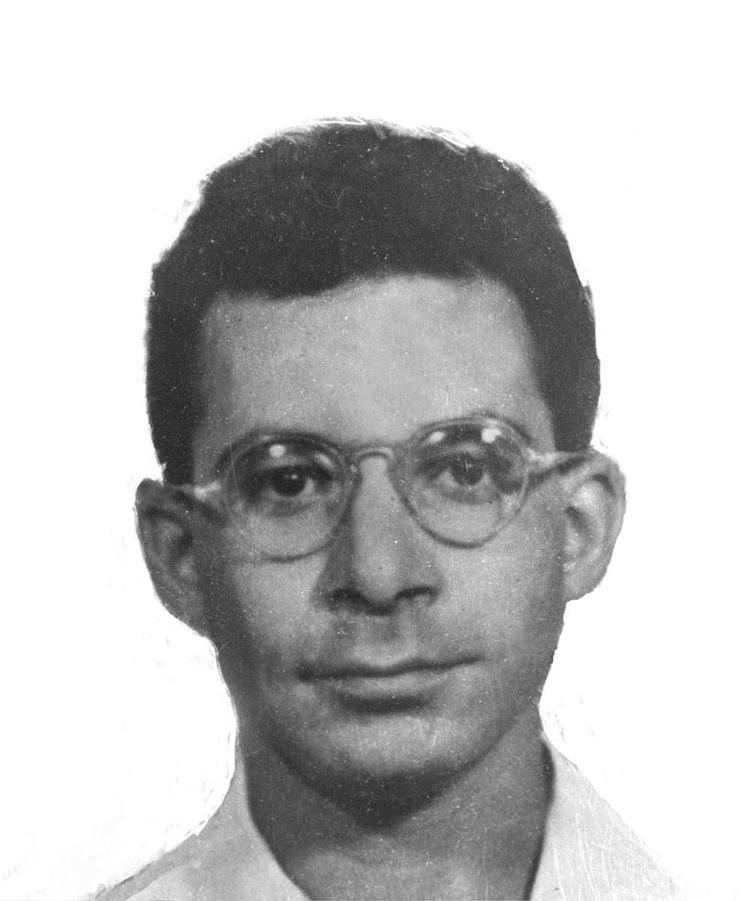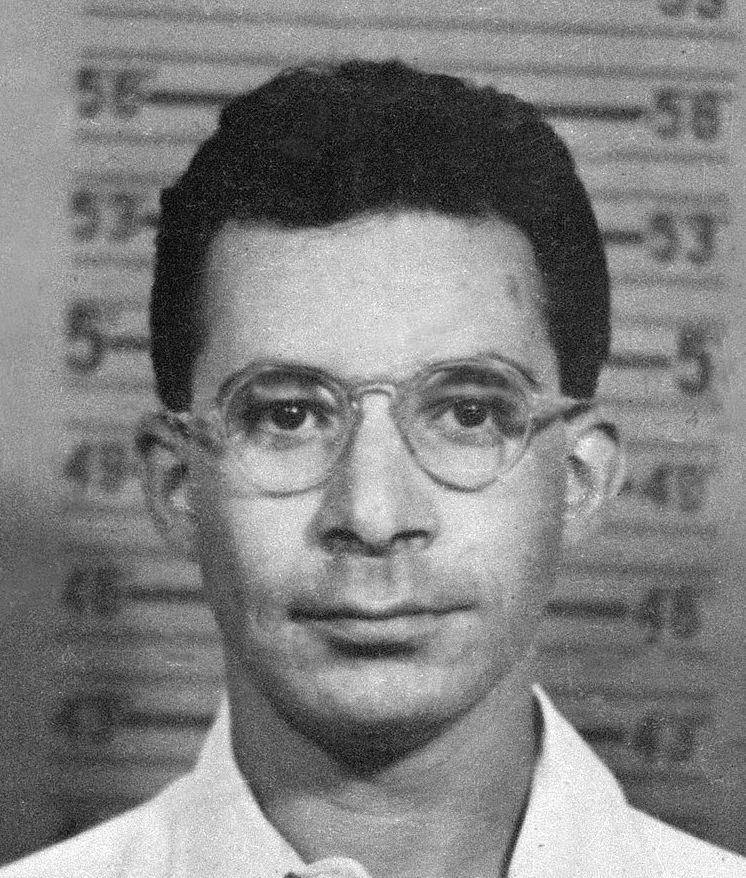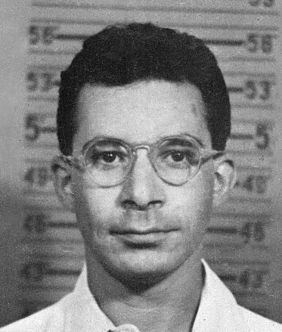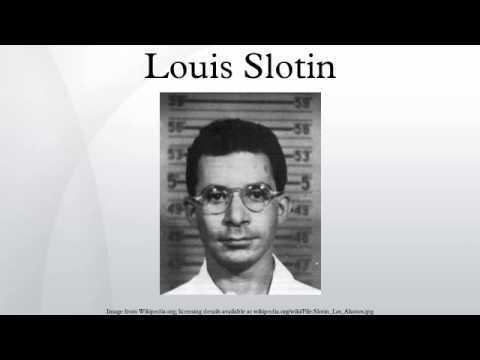Name Louis Slotin | ||
 | ||
Full Name Louis Alexander Slotin Education | ||
End of a year louis slotin
Louis Alexander Slotin (1 December 1910 – 30 May 1946) was a Canadian physicist and chemist who worked on the Manhattan Project. During World War II, Slotin conducted research at Los Alamos National Laboratory. He performed experiments with uranium and plutonium cores to determine their critical mass values. On 21 May 1946, Slotin was conducting a demonstration when he accidentally initiated a fission reaction, which released a burst of hard radiation. He received a lethal dose of radiation and died of acute radiation syndrome nine days later. Slotin was the second person to die from a criticality accident, following the death of Harry Daghlian, who had been exposed to radiation by the same core that killed Slotin. Slotin was publicly hailed as a hero by the United States government for reacting quickly and preventing his accident from killing any colleagues. He was later criticized for failing to follow protocol during the experiment.
Contents
- End of a year louis slotin
- Louis Slotin
- Early life
- Kings College
- University of Chicago
- Work at Los Alamos
- Harry Daghlians death
- Planned return to teaching
- Criticality accident
- Slotins death
- Other injuries and deaths
- Disposition of core
- Radiation dosage
- Legacy
- Dollar unit of reactivity
- References

Others were injured and their deaths years later may have resulted from their radiation exposure. With the end of World War II, the work to build additional nuclear devices was less urgent, and the accident halted work for a while until increased safety protocols were implemented at Los Alamos. The incident and its aftermath have been dramatized in several fictional and non-fiction accounts.

Louis Slotin
Early life

Slotin was the first of three children born to Israel and Sonia Slotin, Yiddish-speaking refugees who had fled the pogroms of Russia to Winnipeg, Manitoba. He grew up in the North End neighborhood of Winnipeg, an area with a large concentration of Eastern European immigrants. From his early days at Machray Elementary School through his teenage years at St. John's High School, Slotin was academically exceptional. His younger brother, Sam, later remarked that his brother "had an extreme intensity that enabled him to study long hours."

At the age of 16, Slotin entered the University of Manitoba to pursue a degree in science. During his undergraduate years, he received a University Gold Medal in both physics and chemistry. Slotin received a B.Sc. degree in geology from the university in 1932 and a M.Sc. degree in 1933. With the assistance of one of his mentors, he obtained a fellowship to study at King's College London under the supervision of Arthur John Allmand, the chair of the chemistry department, who specialized in the field of applied electrochemistry and photochemistry.
King's College

While at King's College, Slotin distinguished himself as an amateur boxer by winning the college's amateur bantamweight boxing championship. Later, he gave the impression that he had fought for the Spanish Republic and trained to fly a fighter with the Royal Air Force. Author Robert Jungk recounted in his book Brighter than a Thousand Suns: A Personal History of the Atomic Scientists, the first published account of the Manhattan Project, that Slotin "had volunteered for service in the Spanish Civil War, more for the sake of the thrill of it than on political grounds. He had often been in extreme danger as an anti-aircraft gunner." During an interview years later, Sam stated that his brother had gone "on a walking tour in Spain", and he "did not take part in the war" as previously thought. Slotin earned a Ph.D. degree in physical chemistry from the university in 1936. He won a prize for his thesis entitled "An Investigation into the Intermediate Formation of Unstable Molecules During some Chemical Reactions." Afterwards, he spent six months working as a special investigator for Dublin's Great Southern Railways, testing the Drumm nickel-zinc rechargeable batteries used on the Dublin–Bray line.
University of Chicago

In 1937, after he unsuccessfully applied for a job with Canada's National Research Council, the University of Chicago accepted him as a research associate. There, Slotin gained his first experience with nuclear chemistry, helping to build the first cyclotron in the midwestern United States. The job paid poorly and Slotin's father had to support him for two years. From 1939 to 1940, Slotin collaborated with Earl Evans, the head of the university's biochemistry department, to produce radiocarbon (carbon-14 and carbon-11) from the cyclotron. While working together, the two men also used carbon-11 to demonstrate that plant cells had the capacity to use carbon dioxide for carbohydrate synthesis, through carbon fixation.
Slotin might have been present at the start-up of Enrico Fermi's "Chicago Pile-1", the first nuclear reactor, on 2 December 1942; the accounts of the event do not agree on this point. During this time, Slotin also contributed to several papers in the field of radiobiology. His expertise on the subject garnered the attention of the United States government, and as a result he was invited to join the Manhattan Project, the United States' effort to develop a nuclear bomb. Slotin worked on the production of plutonium under future Nobel laureate Eugene Wigner at the university and later at the Oak Ridge National Laboratory in Oak Ridge, Tennessee. He moved to the Los Alamos National Laboratory in New Mexico in December 1944 to work in the bomb physics group of Robert Bacher.
Work at Los Alamos
At Los Alamos, Slotin's duties consisted of dangerous criticality testing, first with uranium in Otto Robert Frisch's experiments, and later with plutonium cores. Criticality testing involved bringing masses of fissile materials to near-critical levels to establish their critical mass values. Scientists referred to this flirting with the possibility of a nuclear chain reaction as "tickling the dragon's tail", based on a remark by physicist Richard Feynman, who compared the experiments to "tickling the tail of a sleeping dragon". On 16 July 1945, Slotin assembled the core for Trinity, the first detonated atomic device, and became known as the "chief armorer of the United States" for his expertise in assembling nuclear weapons. Slotin received two small circular lead and silver commemorative pins for his work on the project.
In the winter of 1945–1946, Slotin shocked some of his colleagues with a bold action. He repaired an instrument six feet under water inside the Clinton Pile while it was operating, rather than wait an extra day for the reactor to be shut down. He did not wear his dosimetry badge, but his dose was estimated to be at least 100 roentgen. A dose of 1 Gy (~100 roentgen) can cause nausea and vomiting in 10% of cases, but is generally survivable.
Harry Daghlian's death
On 21 August 1945, laboratory assistant Harry Daghlian, one of Slotin's close colleagues, was performing a critical mass experiment when he accidentally dropped a heavy tungsten carbide brick onto a 6.2-kilogram (14 lb) plutonium-gallium alloy bomb core. The 24-year-old Daghlian was irradiated with a large dose of neutron radiation. Later estimates would suggest that this dose might not have been fatal on its own, but he then received additional delayed gamma radiation and beta burns while disassembling his experiment. He quickly collapsed with acute radiation poisoning and died 25 days later in the Los Alamos base hospital.
Planned return to teaching
After the war, Slotin expressed growing disdain for his personal involvement in the project. He remarked, "I have become involved in the Navy tests, much to my disgust." Unfortunately for Slotin, his participation at Los Alamos was still required because, as he said, "I am one of the few people left here who are experienced bomb putter-togetherers." He looked forward to resuming teaching and research into biophysics and radiobiology at the University of Chicago. He began training a replacement, Alvin C. Graves, to take over his Los Alamos work.
Criticality accident
On 21 May 1946, with seven colleagues watching, Slotin performed an experiment that involved the creation of one of the first steps of a fission reaction by placing two half-spheres of beryllium (a neutron reflector) around a 3.5-inch-diameter (89 mm) plutonium core. The experiment used the same 6.2-kilogram (13.7 lb) plutonium core that had irradiated Harry Daghlian, later called the "demon core" for its role in the two accidents. Slotin grasped the upper 9-inch beryllium hemisphere with his left hand through a thumb hole at the top while he maintained the separation of the half-spheres using the blade of a screwdriver with his right hand, having removed the shims normally used. Using a screwdriver was not a normal part of the experimental protocol.
At 3:20 p.m., the screwdriver slipped and the upper beryllium hemisphere fell, causing a "prompt critical" reaction and a burst of hard radiation. At the time, the scientists in the room observed the blue glow of air ionization and felt a heat wave. Slotin experienced a sour taste in his mouth and an intense burning sensation in his left hand. He jerked his left hand upward, lifting the upper beryllium hemisphere and dropping it to the floor, ending the reaction. However, he had already been exposed to a lethal dose of neutron radiation. At the time of the accident, dosimetry badges were in a locked box about 100 feet (30 m) from the accident. Realizing that no one in the room had their film badges on, "immediately after the accident Dr. Slotin asked to have the badges taken from the lead box and placed on the critical assembly". This peculiar response was attributed to "vertigo" and was of no value for determining the actual doses received by the men in the room.
Others in the room at the time included Raemer E. Schreiber, Alvin Cushman Graves, Stanley Allan Kline, Marion Edward Cieslicki, Dwight Smith Young, Theodore P. Perlman, and Pvt. Patrick J. Cleary.
As soon as Slotin left the building, he vomited, a common reaction from exposure to extremely intense ionizing radiation. Slotin's colleagues rushed him to the hospital, but the radiation damage was irreversible.
By 25 May 1946, four of the eight men exposed during the incident had been discharged from hospital. The Army doctor responsible for the hospital, Captain Paul Hageman, said that Slotin's, Graves', Kline's and Young's "immediate condition is satisfactory."
Slotin's death
Despite intensive medical care and offers from numerous volunteers to donate blood for transfusions, Slotin's condition rapidly deteriorated. Slotin called his parents and they were flown at Army expense from Winnipeg to be with their son. They arrived on the fourth day after the incident, and by the fifth day Slotin's condition started to rapidly deteriorate.
Over the next nine days, Slotin suffered an "agonizing sequence of radiation-induced traumas", including severe diarrhea, reduced urine output, swollen hands, erythema, "massive blisters on his hands and forearms", intestinal paralysis, and gangrene. He had internal radiation burns throughout his body, which one medical expert described as a “three-dimensional sunburn.” By the seventh day, he was experiencing periods of “mental confusion.” His lips turned blue and he was put in an oxygen tent. He ultimately experienced "a total disintegration of bodily functions" and slipped into a coma. Slotin died at 11 a.m. on 30 May, in the presence of his parents. He was buried in Shaarey Zedek Cemetery, Winnipeg, on 2 June 1946.
Other injuries and deaths
Graves, Kline and Young remained hospitalized after Slotin's death. Graves, who was standing the closest to Slotin, also developed acute radiation sickness and was hospitalized for several weeks. He survived, although he lived with chronic neurological and vision problems. Young also suffered from acute radiation syndrome, but recovered. By 28 January 1948 Graves, Kline and Perlman sought compensation for damages suffered during the incident. Graves settled his claim for $3,500.
Three of the observers eventually died of conditions that are known to be promoted by radiation: Graves of a heart attack 20 years later at age 55; Cieslicki of acute myeloid leukemia 19 years later at age 42; and Young of aplastic anemia and bacterial infection of the heart lining 27 years later at age 83. Although some of those deaths were probably latent stochastic (random) effects of the accident, it is not possible to draw any definitive conclusions from such a small sample set.
Disposition of core
The core involved was intended to be used in the Able detonation, during the Crossroads series of nuclear weapon testing. Slotin's experiment was said to be the last conducted before the core's detonation and was intended to be the final demonstration of its ability to go critical. After the criticality accident it needed time to cool. It was therefore rescheduled for the third test of the series, provisionally named Charlie, but this was cancelled due to the unexpected level of radioactivity after the underwater Baker test and the inability to decontaminate the target warships. It was later melted down and reused in a later core.
Radiation dosage
The radiation doses received in these two accidents are not known with any semblance of accuracy. A large part of the dose was due to neutron radiation, which could not be measured by dosimetry equipment of the day. The available equipment, film badges, were not worn by personnel during the accident, and badges that were supposed to be planted under tables in case of disasters like these were not found. Disaster badges hung on the walls did provide some useful data about gamma radiation.
A "tentative" estimate of the doses involved was made in 1948, based on dozens of assumptions, some of which are now known to be grossly incorrect. In the absence of personal dosimetry badges, the study authors relied on measurements of sodium activation in the victims' blood and urine samples as their primary source of data. This activation would have been caused by neutron radiation, but they converted all doses to equivalent doses of gamma or X-ray radiation. They concluded that Daghlian and Slotin had probably received doses equivalent to 290 and 880 rem (respectively) of gamma rays. Minimum and maximum estimates varied from about 50% to 200% of these values. The authors also calculated doses equivalent to a mix of soft 80 keV X-rays and gamma rays, which they believed gave a more realistic picture of the exposure than the gamma equivalent. In this model the equivalent X-ray doses were much higher, but would be concentrated in the tissues facing the source, whereas the gamma component penetrated the whole body. Slotin's equivalent dose was estimated to be 1930 R (roentgen) of X-ray with 114 R of gamma, while Daghlian's equivalent dose was estimated to be 480 R of X-ray with 110 R of gamma. Five hundred rem is usually a fatal dose for humans.
In modern times dosimetry is done very differently. Equivalent doses would not be reported in roentgen; they would be calculated with different weighting factors, and they are not considered as relevant to acute radiation syndrome as absorbed doses. Recent documents have made various interpretations of Slotin's dose, ranging from 287 rad to 21 sievert. Based on citations and supporting reasoning, the most reliable estimate may be a 1978 Los Alamos memo which suggested 10 Gy(n) + 1.14 Gy(γ) for Slotin and 2 Gy(n) + 1.1 Gy(γ) for Daghlian. These doses are consistent with the symptoms they experienced.
Legacy
After the accident, Los Alamos ended all hands-on critical assembly work. Future criticality testing of fissile cores was done with remotely controlled machines, such as the "Godiva" series, with the operator located a safe distance away to prevent harm in case of accidents.
On 14 June 1946, the associate editor of the Los Alamos Times, Thomas P. Ashlock, penned a poem entitled "Slotin – A Tribute":
The official story released at the time was that Slotin, by quickly removing the upper hemisphere, was a hero for ending the critical reaction and protecting seven other observers in the room: "Dr. Slotin's quick reaction at the immediate risk of his own life prevented a more serious development of the experiment which would certainly have resulted in the death of the seven men working with him, as well as serious injury to others in the general vicinity." This interpretation of events was endorsed at the time by Alvin Graves, who stood closest to Slotin when the accident occurred. Graves, like Slotin, had previously displayed a low concern for nuclear safety, and would later allege that fallout risks were "concocted in the minds of weak malingerers." Another witness to the accident, Raemer E. Schreiber, spoke out publicly decades later, arguing that Slotin was using improper and unsafe procedures, endangering the others in the lab along with himself. Robert B. Brode had reported hearsay to that effect back in 1946.
The event was recounted in Dexter Masters' 1955 novel The Accident, a fictional account of the last few days of the life of a nuclear scientist suffering from radiation poisoning. Depictions of the criticality incident include the 1989 film Fat Man and Little Boy, in which John Cusack plays a fictional character named Michael Merriman based on Slotin, and the Louis Slotin Sonata, a 2001 off-Broadway play directed by David P. Moore.
In 1948, Slotin's colleagues at Los Alamos and the University of Chicago initiated the Louis A. Slotin Memorial Fund for lectures on physics given by distinguished scientists such as Robert Oppenheimer and Nobel laureates Luis Walter Alvarez and Hans Bethe. The memorial fund lasted until 1962. In 2002, an asteroid discovered in 1995 was named 12423 Slotin in his honour.
Dollar unit of reactivity
According to Weinberg and Wigner, Slotin was the pioneer in suggesting the term "dollar" to describe the reactivity interval between delayed and prompt criticality. Here, "0" represents the threshold of a self-sustaining nuclear chain reaction. At the point termed a "dollar," the chain reaction can continue without the need for slowly released, delayed neutrons, transitioning into what is known as "prompt (super-)critical" territory. Nuclear reactors are designed to function within the range from 0 to a dollar for stability, whereas scenarios exceeding a dollar are characteristic of rapid power increases or nuclear explosives.The hundredth part of a dollar is called a cent (reactivity). When speaking of purely prompt critical events, some users refer to cents "over critical" as a relative unit.
